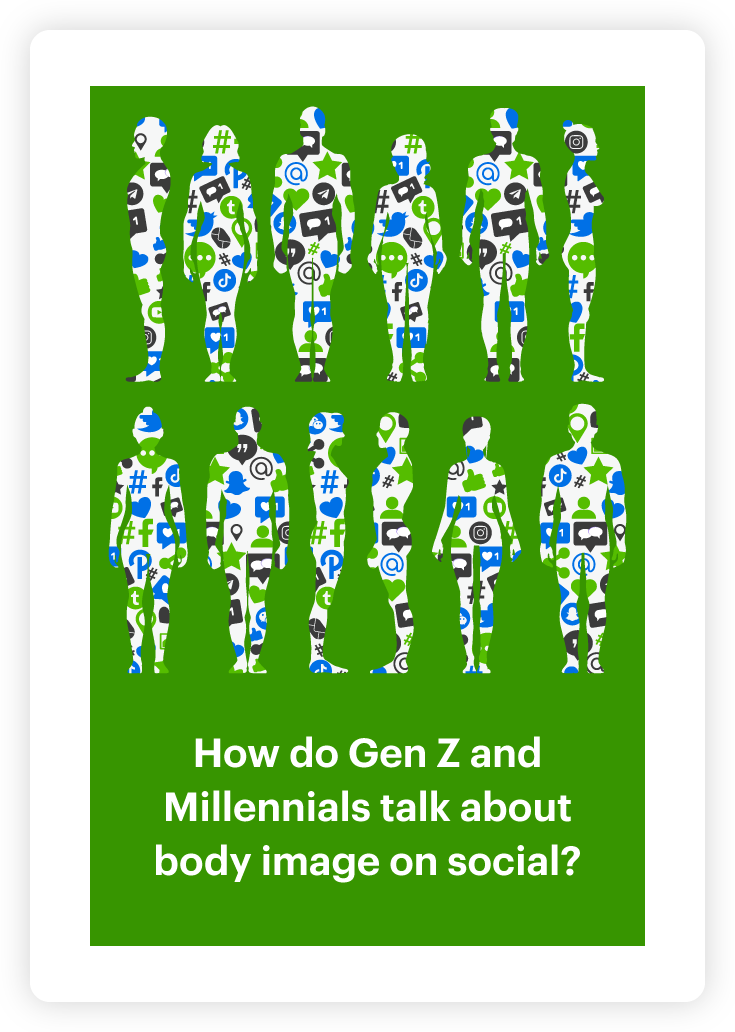Monitoring post-pandemic consumer travel trends

The past few years have brought major disruptions to the travel industry. But as the impact of Covid-19 recedes, catching a flight to explore a new place is returning to normal. As international tourism rebounds, businesses in the travel and tourism sector are analyzing social media data to extract customer insights into consumer travel trends as travelers prepare to resume their globetrotting.
Analyzing topical social media conversations gathered through a social listening tool can help organizations understand what prospective travelers want from their vacations, identify the kinds of trips people are interested in – plus when they’re interested in them – and articulate how the pandemic is impacting consumer travel trends.
We used Relative Insight Heartbeat to analyze holiday-related online conversations over the past three years. Heartbeat provides an objective, efficient and scalable way to visualize changes in the most important themes in your qualitative data over time.
In this instance, Relative Insight defined six themes to visualize in the data:
- Beach vacations
- Ski vacations
- Cruises
- Desire to book a vacation
- Caution
- Confidence
Applying these themes to social media data to create a Heartbeat chart, Relative Insight gained understanding into the minds of prospective travelers by visualizing how discussion of each theme has changed over time.
Track and analyze social media data over time using Heartbeat
Analyzing social media data with Heartbeat between 2021 and 2022
Types of holidays
Beach, ski, cruise


The Heartbeat chart reveals seasonal peaks and patterns in destination interest. Understanding exactly when discussions of a particular type of holiday are picking up can help hotels, airlines and other tourism operators plan their communications and promotions to target their audiences at the right time.
Discussions of beach holidays including words like ‘beach’, ‘sea’ and ‘coast’ were consistently high from April through July before trailing off, then rebounded in December and January. Consumers are most likely to think of beach destinations in the lead up to the traditional summer vacation period, however, there is also an opportunity in the cooler winter months when the weather at home gets people yearning for sunnier skies.
An uptick in discussions of ski vacations between October and January indicates this is the period during which people think about and plan them. A smaller increase between July and August indicates the early birds may be thinking ahead to their ski vacations as summer is coming to an end.
It’s no secret the early days of the pandemic were disastrous for the cruise industry. At the beginning of 2021, online discussion of cruises had plateaued. Yet in recent months we’ve witnessed growth in the proportion of conversations being dedicated to this theme, although ski and beach vacations still represent a much larger proportion of the conversation. Increased chatter about cruises reflects improving consumer confidence that cruises are safe and will go ahead. This uptick is a positive sign the cruise industry is coming back to life.
Paying close attention to when discussions of specific themes are taking off in consumer discourse can provide valuable insight into the customer journey and help brands reflect this in their marketing.
Emotions
Confidence, caution
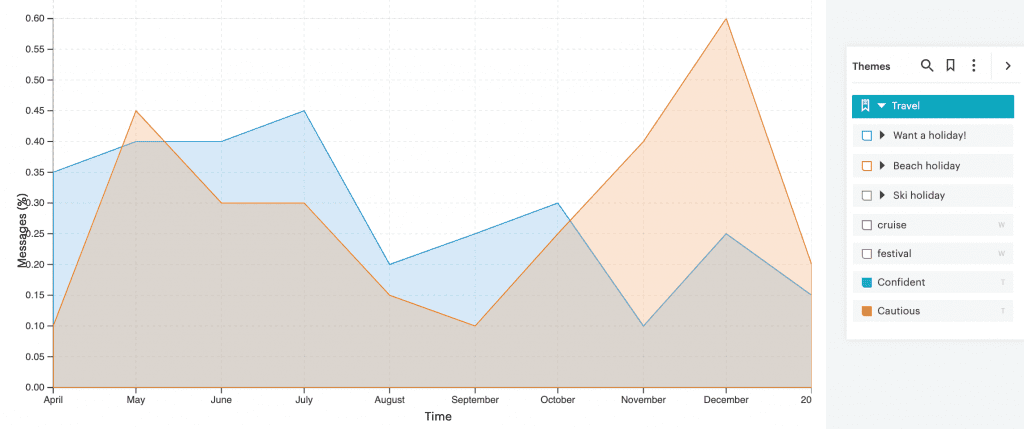

Heartbeat also enabled us to monitor changes in the emotions of target audiences — and hence consumer travel trends. Specifically, Relative Insight tracked the themes of ‘confidence’ and ‘caution’ in online discussions to gain insight into the mindset of consumers.
The Heartbeat chart reveals that caution spiked in May 2021, as countries began exiting lockdown and consumers contended with often-confusing sets of travel restrictions. In the two months that followed, we can see caution dropping off and confidence reaching a peak, signaling people were leaving pandemic fears behind as summer approached and vaccination rates increased.
Despite conversations of caution dipping over the spring and summer, we observed a sharp rise during October and November 2021, aligning with the arrival of the Omicron variant. A worsening Covid-19 situation combined with a desire to spend the holidays with friends and family likely contributed to sustained cautious attitudes through the end of 2021.
January saw the return of traveler confidence alongside a considerable decrease in the proportion of the conversation expressing caution. This was a positive indicator of consumer confidence in the travel sector for 2022.
Desire for holiday
Need, want, booked, dream
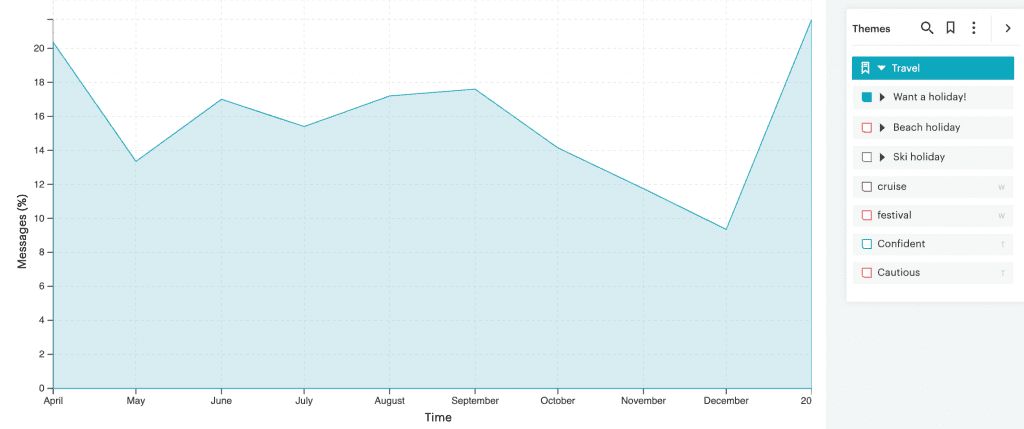

The start of a new year is an exciting and important time for the travel industry. For many consumers, travel is top of mind as they look to plan fun adventures for the year ahead and inject some excitement into the quiet post-Christmas period. Looking at the prevalence of words relating to purchase intent, such as want, need, dream and book, we saw the proportion of conversation dedicated to this theme double between December and January.
The new year is the time when target audiences are planning trips, dreaming of vacations and acting on their desires to book. Brands should aim to maximize advertising spending around this time to ensure they are capitalizing on consumer enthusiasm.
2022 and beyond reveals intertwined cyclical travel trends
One of the beauties of Relative Insight Heartbeat is that you can continually add data to see how trends are evolving in real time. Using the same search parameters within a social listening tool, we set about analyzing social media data for the remainder of 2022 and the initial part of 2023.
This revealed that trends uncovered in 2021 and early 2022 are cyclical. Covid-19’s impact on the sector has abated and consumer travel trends have returned to normal. This cycle is most apparent in the Heartbeat chart mapping conversations around beach and ski vacations.
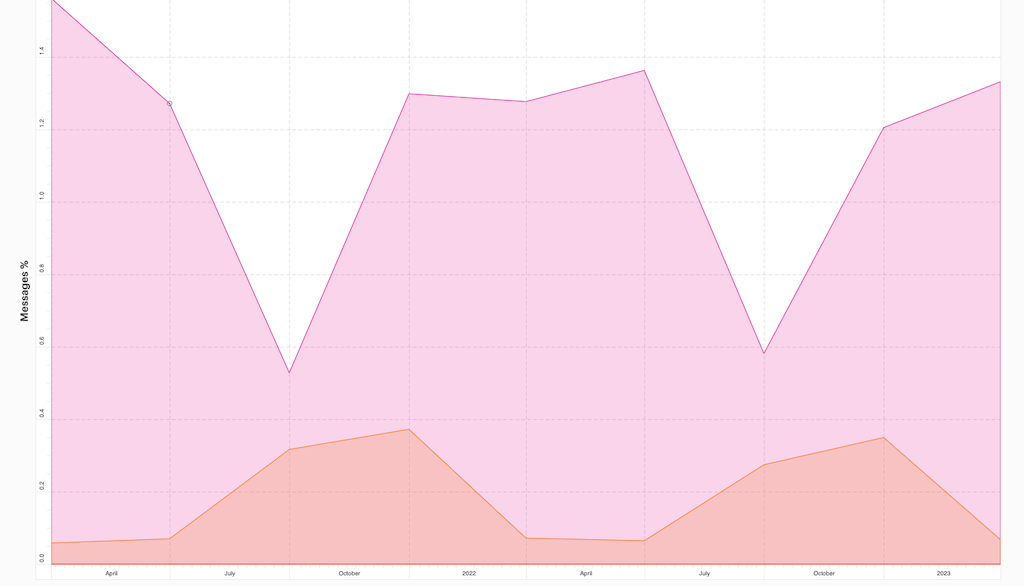

Discussions about beach vacations were high for most of the year, only falling between the end of summer and mid-autumn. They peaked in January — where poor weather has travelers dreaming of sun, sea and sand. Similarly, conversations around ski vacations begin to increase between April and July, peaking at the height of ski season in December.
While travel companies will be aware of seasonal cycles through bookings and other types of commercial data, augmenting this knowledge with consumer trends by analyzing social media data provides even better intelligence as to when and how they should market different types of trip.
Heartbeat charts also illustrate the relationship between different themes. This helps you to spot and react to any correlation in how consumers talk about various aspects of your text data.
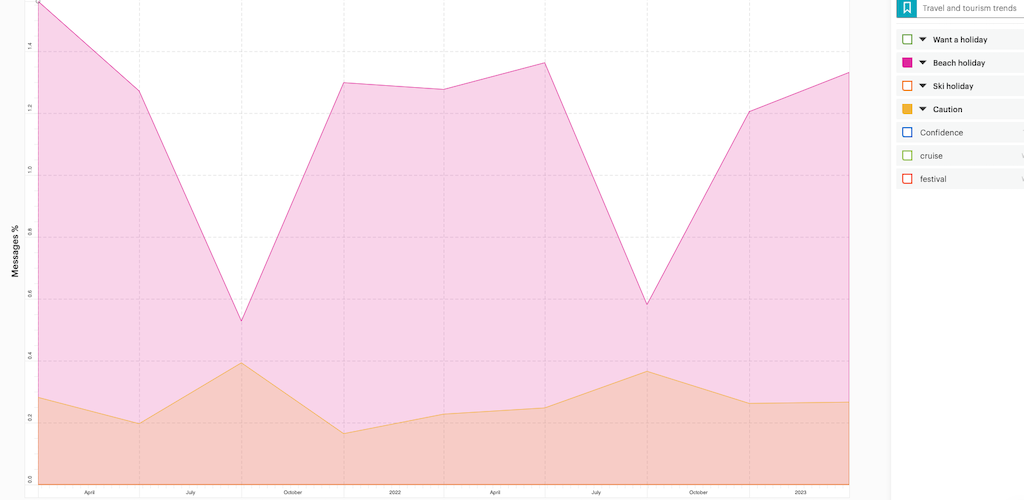

The chart shows a clear negative correlation between discussions around beach vacations and those expressing caution. By digging into the verbatims, it’s clear that excitement and desire plays a key part in beach vacation sentiment. When travelers aren’t excited by the prospect of a beach or haven’t reached the point where they need the dopamine hit of a booking a vacation, then they consider the challenges involved.
“Happened again. Just got back from vacation and wonder why I go this hassle every year. Might avoid it next year, but probs not lol 🙃.”
Travel companies looking to increase beach vacation bookings in this fallow period need to appeal to travelers’ logical thinking. Offering discounts on impulse trips or early access to certain destinations outside peak times during this period compensates for people’s caution — booking makes sense, rather than fulfils a need.
Monitoring consumer travel trends with Relative Insight Heartbeat
When it comes to consumer behavior, the travel industry is a perfect illustration of the importance of staying on top of audience trends. Consumer travel trends, i.e. what people want from their vacation experience, are cyclical and correlate to one another. The companies that understand and react to these trends are those best placed to boost bookings.
Heartbeat makes it easy for brands and agencies to identify important trends in online conversations over time and talk to their target audiences about the right things, at the right time, in the right context. Heartbeat charts provide a powerful, easy-to-understand visual that can easily be updated with the latest data to support “always-on” market research intelligence.
